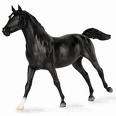Like human beings horses are affected by arthritis too. Pain, stiffness and swelling around the joints are some of the symptoms that are to be found in horses suffering from the same. Symptoms of horse arthritis should never be ignored and the horse should never be burdened with physical activity in such cases. It is sad to see many a promising racing and equestrian careers being affected by stress in the weight bearing joints, or dysfunctional abilities in the regular movements of the animal.
It is usually horses above the age of 15 which are especially prone to arthritis since the cartilage begins to wear out very quickly after that age. Some older horses are also affected by loosened tendons and ligaments resulting in inflammation, joint instability tremendous pain.
One should never ignore the seriousness of the disease in horses lest it may cripple the animal from regular physical activity which is vital to horses. Horse arthritis is treatable and manageable once it is detected early enough. Some common symptoms may be stiffness seen after sleep or standing for a long time, swellings on certain joints, an obvious tendency to limp after exercises or prolonged walking. At times one might notice changes in the horse's performance or general differences in the animal's behavior.
Even while administering medicines to the horses, many owners have tried to experiment with alternative processes like magnotherapy, where products related to this method of treatment are worn by the horse to help in relieving pain.
Magnotherapy products have been developed specifically for animals help in healing process apart from increasing energy levels and help reduce intense pain. By using a unique pattern of magnetic fields, these specifically designed products help the animals retain their normal activity in their daily lives. Owners should realize that while buying these products one must check on the CPR (Central Reverse Polarity) technology which simulates the pulsed field and alternating poles of an electromagnet and gives an advantage over the magnets which do not follow this kind of technology, rendering them practically useless.
Magnotherapy has the advantage of being totally non-invasive. It is quick and easy to use these products and they have no known harmful side effects have been seen. The metabolism in the animal body responds well to magnotherapy. There are many happy families who have tried an intelligent blend of regular medicines aligned with magnotherapy products to cure their animals. Products related to this therapy are available in the form of boots, tendon wraps, horse rugs, etc which are effectively used to curb the pain resulting from arthritis, rheumatoid arthritis, joint and muscle stiffness, lameness, hip dysplacia, ringbone and many associated problems.
Article Source: http://EzineArticles.com/?expert=Maitreyee_Chowdhury
Read More..



